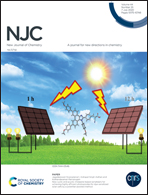Direct conversion of cellulose into isosorbide over Ni doped NbOPO4 catalysts in water†
Abstract
Isosorbide is a versatile chemical intermediate for the production of a variety of drugs, chemicals, and polymers, and its efficient production from natural cellulose is of great significance. In this study, bifunctional catalysts based on niobium phosphates were prepared by a facile hydrothermal method and used for the direct conversion of cellulose to isosorbide under aqueous conditions. NH3-TPD analysis showed that a high acid content existed on the catalyst surface, and pyridine infrared spectroscopic analysis confirmed the presence of both Lewis acid and Brønsted acid sites, both of which played an important role in the process of carbohydrate conversion. XRD and H2-TPR characterization determined the composition and the hydrogenation centers of the catalyst. An isosorbide yield of 47% could be obtained at 200 °C for 24 h under 3 MPa H2 pressure. The Ni/NbOPO4 bifunctional catalyst retains most of its activity after five consecutive runs with slightly decreased isosorbide yield of 44%. In addition, a possible reaction mechanism was proposed that the synergistic effect of surface acid sites and hydrogenation sites was favorable to enhancing the cascade dehydration and hydrogenation reactions during the conversion of cellulose to isosorbide. This study provides as an efficient strategy for the development of novel multifunctional heterogeneous catalysts for the one-pot valorisation of cellulose.



 Please wait while we load your content...
Please wait while we load your content...